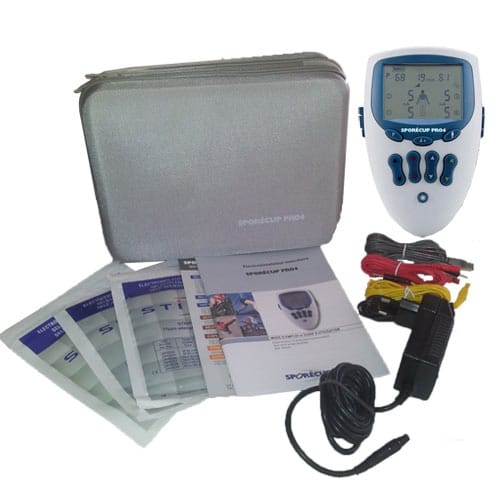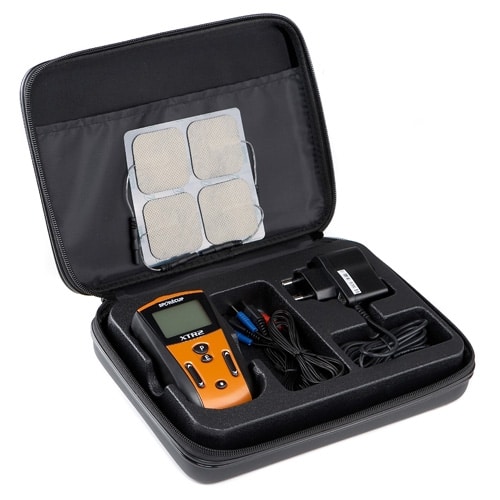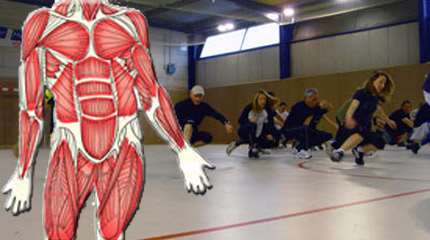Skating and Electro-Stimulation
You want to surpass yourself and improve your skating performances? Weather conditions are not good enough during winter time for an efficient skating training? There may be a solution up to your sports motivation: electro-stimulation…
Par alfathor
A good supplement but not a training session in itself
What is an electronic muscle stimulator (EMS)?
 An EMS machine is a miniaturized electric generator which transforms alternating current into excito-motor current, as long as the conduction electrodes are placed on the motoneurones of the muscle. A map of the main points is usually included into the machine’s package.
An EMS machine is a miniaturized electric generator which transforms alternating current into excito-motor current, as long as the conduction electrodes are placed on the motoneurones of the muscle. A map of the main points is usually included into the machine’s package.
How does it work?
An EMS machine enables skeletal muscles to contract involuntarily. Current replaces nerve impulse. It is called passive gymnastics.
Low frequency currents (most of the time between 20 and 100 Hz) are used to get an involuntary contraction of the muscle for sports purposes. There are several programs available:
- venous return improvement
- muscle mass reinforcement
- resistance
- endurance
- relaxation
The size of the electrodes influences the skin resistance to current passing (1): With a small electrode, the area will be more precisely localized and more current will pass, but the tingling sensation will be all the more important.
The most common set-up is preferentially bipolar current with two electrodes placed on the proximal and distal parts of the muscle, the further apart as possible in order to get in-depth action (2).
Are there true scientific bases supporting electro-stimulation?
Several studies have been implemented since the beginning of the 20th C. on the use of EMS machines. They all showed that maximum muscle strength improved of between 20 and 30 % after 5 weeks of EMS training, at a rate of 3 weekly sessions of 12 min at a bearable intensity, with cycles of 5 sec of contraction for 15 sec of rest, while no improvement was noticed on the control group (3).
 Combined with dynamic voluntary exercises, EMS also leads to some improvement in the specific skills and performances of the practiced discipline (4).
Combined with dynamic voluntary exercises, EMS also leads to some improvement in the specific skills and performances of the practiced discipline (4).
Low frequency EMS significantly improves isometric muscle strength. There is no improvement of dynamic/plyometric strength unless it is coupled with voluntary training. EMS remains a backup method for training volume at a lesser level of tiredness.
From a neurological point of view, study teams found that EMS training improved the general activity of the stimulated muscle: motor nerves are able to activate more muscle fibers with ESM, whereas voluntary contractions recruit muscle fibers in rotation and in a dispersed way, which provides relative rest and a higher duration of exercise. Nervous adaptations take place within the first 4 weeks of training, while muscle adaptation becomes significant within 4 to 8 weeks (4).
EMS revealed a better cardio-respiratory adaptation to effort than voluntary contraction, by measuring O2 consumption into blood gases and muscle fatigability (6).
What use would that machine be to my skating practice?
– You can improve your venous return and thus your muscle decongestion due to training: you can ‘wash’ the metabolic toxins resulting from exercise; Regular and rhythmic soft contractions have a ‘pump’ effect on your intro-muscle blood circulation.
– You can vary your training program, a motivation factor for some skaters. Then you can train while reading a book or watching TV, or just meditating on a sofa.
– You can reduce muscle pains in increasing the production of endorphins and enkephalins (natural substances with analgesic properties) in using a recovery program. Muscular work always causes an ‘appeasing’ hormonal release. You are in an second state, artificial but quite pleasant, which generates effort addiction! Yes, we are all sports addicts…
– You can recover actively without overloading your joints and tendons. Indeed, muscles contract isometrically without joint movement, so that you work without tiring the peripheral structures of your muscles.
– According to the program, you can decrease muscle tension with a relaxing effect on muscle fibers. Contrary to muscle reinforcement programs, the ‘active recovery’ program doesn’t cause powerful contractions, but merely muscle twitching resulting in massage sensation.
Awesome, no need to train on skates!
 Actually you do, as sports performance is the result of the sum of many qualities: cardio-vascular, technical… and muscular skills. Thinking that electro-stimulation is a complete training would be illusory.
Actually you do, as sports performance is the result of the sum of many qualities: cardio-vascular, technical… and muscular skills. Thinking that electro-stimulation is a complete training would be illusory.
EMS can be used as a supplement of your dynamic training. However, active recovery after training, based on the continuation of the drill at medium intensity, was proved to enable the easier elimination of lactates and the softening of myofilaments, as well as to prevent sore muscles the next day.
With evaluations made on three groups of competition swimmers, it was observed that the recovery method by swimming at a sub maximum intensity led to the biggest drop of lactate rate in the blood for the first group.
The ESM recovery still led to a noticeably bigger drop of that rate for the second group, compared to the third group on imposed rest recovery (5).
EMS may be uncomfortable, even painful (stronger activation of sensory and motor primary areas, proportional to the EMS intensity).
And what about warm-ups?
As for warm-up programs, let’s express serious reservations. Indeed, the aim of that preparation is to increase the body temperature in order to increase your abilities for muscle effort, improve the viscoelasticity of your muscles and of the surrounding areas, lubricate your joints and above all make you feel confident as for motor coordination. Yet, as mentioned above, ESM doesn’t improve that.
Contraindications
There are contraindications: epilepsy, pregnant women, pacemaker holders, cardiac arrhythmia, venous thrombosis, arterial ischemia of lower limbs, abdominal or inguinal hernia.
Which EMS machine to choose?
Obviously such a machine, able to produce currents up to 120 mA and 150 Hz with battery or power supply, is a bit more expensive than 15€ (there are products at that price on the market). But don’t go and get your machine at a paramedical products retailer, it would be too much: Your physiotherapist doesn’t have the same budget as you. You should find what you need in a 150€-300€ price range.
EMS or not EMS?
Why not! That type of machine as been used for physical rehabilitation since the 50’s and it was compulsory in the training programs of ex-URSS athletes, which is quite a token of results.
Useful Links
Integrating muscle workout into skating training
The main principles of cross training for skating
References
(1) Moreno Aranda and Seireg, 1981.
Gondin and al., European Journal of Applied Physiology, Oct 2011, Vol. 111(10), pp. 2473-87.
(2) Myklebust, 1989.
(3) « Effects of An Electrostimulation Training Program on Strength, Jumping, and Kicking Capacities in Soccer Players. »?Billot et al., Journal of Strength and Conditioning Research, May 2010, Vol. 24(5), pp. 1407-1413.
(4) « Electromyostimulation Training Effects on Neural Drive and Muscle Architecture. »
Gondin and al. Medicine & Science in Sports & Exercise, 2005, Volume 37(8) pp. 1291-1299.
(5) Theurel J and al. Differences in cardiorespiratory and neuromuscular responses between voluntary and stimulated contractions of the quadriceps femoris muscle. Respir Physiol Neurobiol. 2007 Aug 1; 157(2-3):341-7.
(6) « Comparison of swim recovery and muscle stimulation on lactate removal after sprint swimming. »Neric and al., Journal of Strength and Conditioning Research, Dec 2009, Volume 23(9) pp. 2560-2567.
Translation: Chloe Seyres
Photos : rollerenligne.com and all rights reserved
